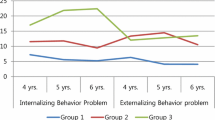Abstract
Nearly all 3-year-old Chinese children in Hong Kong attend preschool facilities, making it possible to study their behavior in a group learning situation based upon teachers' perception. The Preschool Behavior Checklist (PBCL), a teacher's questionnaire, was applied to a random sample of 851 Chinese children, ages 36 to 48 months. The factor structure of the PBCL was very similar to that obtained from its original British study, supporting its usage cross-culturally. Prevalence of behavior disorder was high as defined by the PBCL. This reflected specific cultural demands at school settings. Significant sex differences were also found in the overall rate of behavior disorder and symptom patterns. As in other studies, boys had more hyperactive, conduct, and speech problems. The results suggested a certain degree of universality of symptomatology for children at the preschool level.
Similar content being viewed by others
References
Behar, R., & Stringfield, S. (1974). A behavior rating scale for the preschool child.Developmental Psychology, 10, 601–610.
Chazan, M., Laing, A., Shackleton, B. M., & Jones, G. (1980).Some of our children. The early education of children with special needs.London: Open Books.
Clarigio, H. F., & McCoy, G. F. (1970).Behavior disorders in school-aged children. New York: Chandler Publishing.
Clark, M. M., & Cheyne, W. W. (1979). Handicapped and exceptional children in pre-school units. In M. M. Clark and W. W. Cheyne (Eds.),Studies in preschool education (pp. 152–217). London: Hodder & Stoughton.
Conners, C. K. (1969). A teacher rating scale for use in drug studies with children.American Journal of Psychiatry, 126, 884–888.
Earls, F. (1980). Prevalence of behavior problems in 3-year-old children: A cross-national replication.Archives of General Psychiatry 37, 1153–1157.
Fowler, F. C., & Park, R. M. (1979). Factor structure of the Preschool Behavior Questionnaire in a normal population.Psychological Reports 45, 559–600.
Graham, P. J. (1986).Child psychiatry: A developmental approach. Oxford: Oxford University Press.
Hinshaw, S. P. (1987). On the distinction between attentional deficits/hyperactivity and conduct problems/aggression in child psychopathology.Psychological Bulletin, 101, 443–463.
Jenkins, S., Bax, M., & Hart, H. (1980). Behavior problems in preschool children.Journal of Child Psychology and Psychiatry, 21, 5–17.
Kaplan, H. I., & Sadock, B. J. (1985).Modern synopsis of comprehensive textbook of psychiatry/IV. Baltimore: Williams & Wilkins.
Kohn, M., & Rosman, B. L. (1973). A two-factor model of emotional disturbance in the young child.Journal of Child Psychology and Psychiatry, 14, 31–56.
Luk, S. L., Leung, P. W. H., Bacon-Shone, J., Chung, S. Y., Lee, P. W. L., Chen, S., Ng, R., Lieh-Mak, F., Ko, L., Wong, V. C. N., & Yeung, C. Y. (1991). Behavior disorder in preschool children in Hong Kong —A two stage epidemiological study.British Journal of Psychiatry, 158, 263–221.
Luk, S. L., Leung, P. W. L., & Lee, P. L. M. (1988). Conners' Teacher Rating Scale in Chinese children in Hong Kong.Journal of Child Psychology and Psychiatry, 29, 165–174.
McQuire, J., & Richman, N. (1986a). Screening for behavior problems in nurseries: The reliability and validity of the preschool behavior checklist.Journal of Child Psychology and Psychiatry, 27, 7–32.
McQuire, J., & Richman, N. (1986b). The prevalence of behavioral problems in three types of preschool group.Journal of Child Psychology and Psychiatry, 27, 455–472.
Rapoport, J. L., Donnelly, M., Zametkin, A., & Carrougher, J. (1986). “Situational hyperactivity” in a U.S. clinical setting.Journal of Child Psychology and Psychiatry, 27, 639–646.
Richman, N., & Graham, P. J. (1971). A behavioral screening questionnaire for use with 3-year-old children: Preliminary findings.Journal of Child Psychology and Psychiatry, 12, 5–33.
Richman, N., Stevenson, J., & Graham, P. J. (1982).Pre-school to school: A behavioral study. London: Academic Press.
Taylor, E. (1984). Nosology of attention deficit and conduct disorder syndromes. Paper presented at the research workshop on assessment, diagnosis, and classification in child and adolescent psychopathology, Clinical Research Branch, NIMH, September 10–11, 1984.
Wolff, S. (1961). Social and family background of preschool children with behavior disorders attending a child guidance clinic.Journal of Child Psychology and Psychiatry, 2, 260–268.
Author information
Authors and Affiliations
Additional information
This project was funded by the Hong Kong Society for Child Health and Development. We are grateful to all the kindergartens and child care centers which participated in this project. Valuable assistance was provided by the Education Department and the Medical Health Department.
Rights and permissions
About this article
Cite this article
Luk, S.L., Leung, P.W.L., Bacon-Shone, J. et al. The structure and prevalence of behavioral problems in Hong Kong preschool children. J Abnorm Child Psychol 19, 219–232 (1991). https://doi.org/10.1007/BF00909979
Revised:
Issue Date:
DOI: https://doi.org/10.1007/BF00909979



